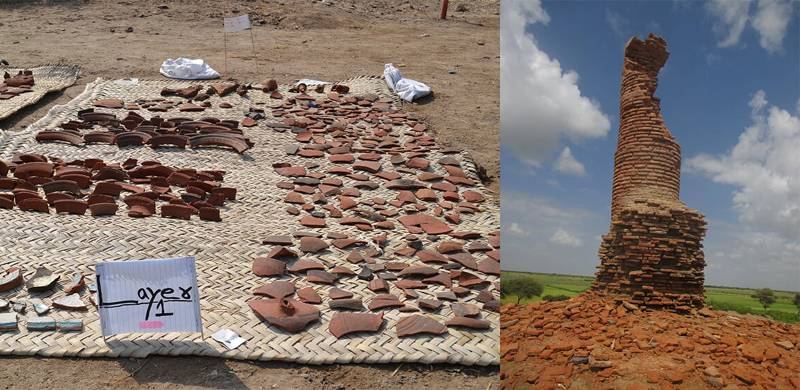
Travelling of around 3 kilometers to the east from the city Kario Ghanwar, District Badin, Sindh will take you to a site board mentioning the distance and direction to reach ‘Kaath Banbhan Jo Daro’. From that point the journey of around 8 kilometers to the north in district Tando Muhammad Khan will take you to the historical Kaath Banbhan Jo Daro (Mound of Kaath Banbhan).
Locals have been calling it ‘Kaath Banbhan Jo Daro’ for years but no one knows how the mound actually got this unexplained name. Surrounding this mysterious mound, there is a village of people who call themselves ‘Kaath Banbhans’ but they too can’t exactly explain where from and how they adopted that cast.
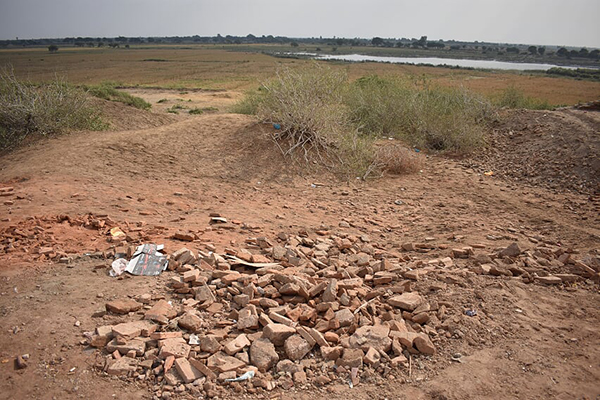
Some villagers have a mythical belief that they are originally descendants of a ‘Raahib’ (preist) who kept Imam Hussain’s (A.S) holy head for one night after the Karbala tragedy, while some say that they are the followers of a saint namely Makhdoom Ibrahim who is buried in the graveyard near Kaath Banbhan Jo Daro.
So what’s the history of Kaath Banbhan Jo Daro? How old is this mound? How was it destroyed? To which time period does it belong? To find out answers of these and many other such questions if one would go through the books on the history of Sindh, they would find nothing related to the mound except one or two close references pertaining only to the location where Kaath Banbhan Jo Daro is currently located. The rest of the books are absolutely silent.
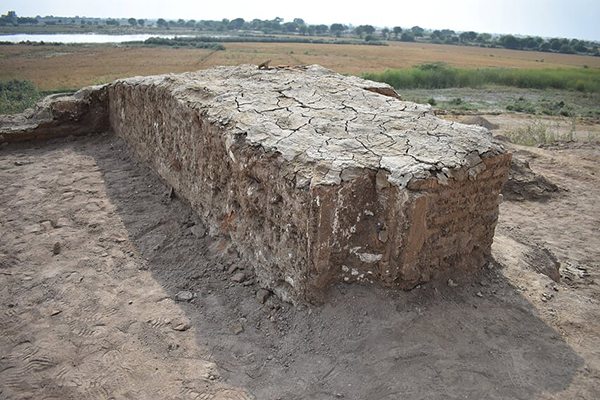
The mound is stretched over an area of around 14 acres with the height of around 20 feet from the ground. There is also a 15 feet high mysterious tower (Devri or Thhul in Sindhi) located on the mound which is made of baked bricks. Owing to facing severe shocks of the times the tower was in shambles till some months ago but the recent restoration work on the mound by Endowment Fund Trust has given the tower a ‘new life’.
Till the revelation of a Sindhi article by a local writer Ali Bha about the ‘Mound of Kaath Banbhan’ in the Sunday magazine of Daily Kawish (a well-known Sindhi newspaper), very few people had any idea about this historical mound. Soon after publishing of the article, people from different walks of life started contacting Ali Bha and this is how this site got fame among the history lovers and researchers and came under spotlight. Ali Bha’s write-up was also a blueprint for Sindh government’s Antiquities department to kick off restoration and preservation work on the mound but no one came forward to save the historical site governmentally.
https://www.youtube.com/watch?v=RFoE2cBJtls
In November 2018, a team comprising of students from Sindh University, Mehran University and Shah Latif University along with researchers and archeologists like Ishtiaque Ansari and Neelofer Shaikh from Centre for documentation and conservation of the heritage of Sindh, Endowment Trust Fund (ETF) reached at the mound and started excavation and preservation work. The team worked there for around 10 days and then went back. During the excavation work, they found broken pieces of outdated pots, bricks, statues and stamps which they sent to the laboratory for further research.
Exploring the history
The veteran Sindhi writer M.H Panhwar in his book ‘Tasveer-e-Sindh’ has just listed the ‘Mound of Kaath Banbhan’ among the destroyed historical sites and monuments during Soomra dynasty. Moreover, the books of a local historian and writer Soomar Shaikh also give a murky depiction of the history of this mound.
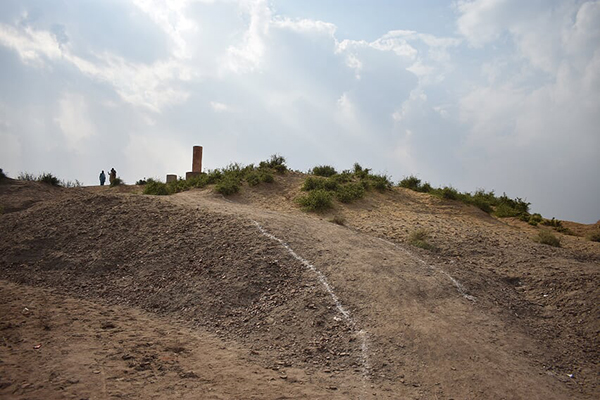
When the history lovers and historians were contacted so that some comprehensive clue could be locked up regarding the history of this mound, they all had upsetting opinions on the subject. Some say how one can consider the mound a historical site as it even couldn’t find any place in our history books. Another friend has the opinion that if such mysterious mounds really had something astonishing in their existences then why did Britishers turn a blind eye on the research work regarding such unexplored mounds during their Raj.
Ali Bha, a local writer who was the first one to pen down something on the mysterious mound of Kaath Banbhan and drew the attention of the local historians, says, ”I am extremely astonished why Doctor Nabi Bux Khan Baloch (a prominent research scholar of Sindh) didn’t write any research paper about this mound. I am also depressed to see the reaction of local researchers and history lovers regarding kicking off the research work on the mound. For any reason if the British failed to document the footsteps of such mysterious cum historical mound, then we too should avoid researching such historically rich sites?”
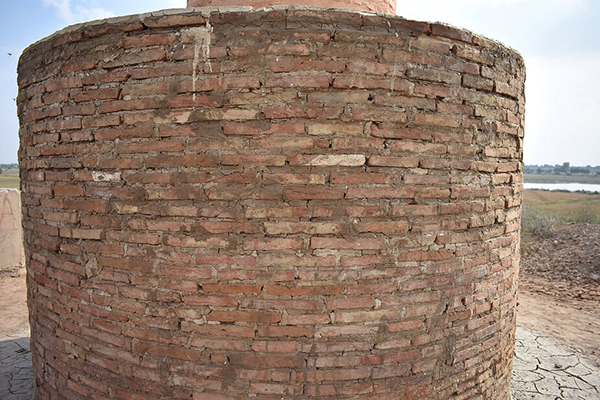
“Anyway, if the Kaath Banbhan Jo Daro couldn’t find any place in Sindh’s history books or remained unexplored by the historians, there might be several reasons behind such ignorance. Whatsoever should be the reasons, one thing is confirmed that this isn’t only a mound but a history buried under the soil,” Ali Bha added.
Some researchers predict that ‘Kaath Banbhan Jo Daro’ and ‘Bhet Waro Qillo’ (the Island Fort, where Muhammad Bin Qasim along with his soldiers took rest for three months after crossing Mehran Darya and made strategy to kick off the decisive war against Raja Dahir) may be the one place with two different names. ‘Chachnama’, the only firsthand account defining the history of Sindh, narrates that there used to be ‘Bhet Waro Qillo’ somewhere around the same location as of Kaath Banbhan Jo Daro but it can’t be taken as authentic evidence so far because ‘Chachnama’ failed to point out the accurate location of ‘Bhet Waro Qillo’.
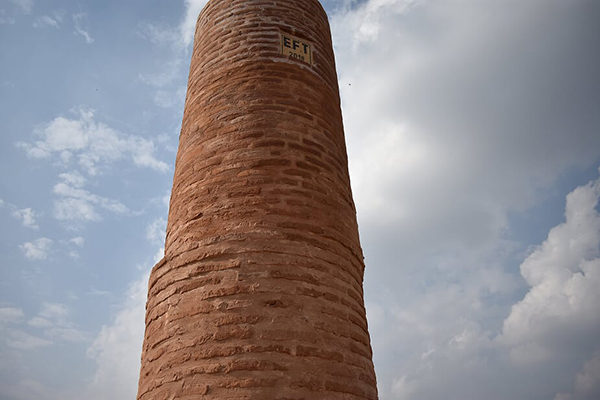
The writer Hussain Badshah in his Sindhi book ‘Hyderabad Ji Tareekh’ (History of Hyderabad) mentions that ‘Bhet Waro Qillo’ might be located somewhere in south of the district Tando Muhammad Khan. The prominent writer and research scholar MH Panhwar in his Sindhi book ‘Sindh Ji 6000 Saal Puranni Rejanni Tareekh’ displayed an old map of Sindh in which he marked ‘Rawarr’ near Talhar (Presently a Taluka of district Badin) and from ‘Rawarr’ he drew a line mentioning the location of ‘Bhet Waro Qillo’ to the west, which also indicates that both the places could be same. Masood Lohar, a young research scholar also has the view that Kaath Banbhan Jo Daro is actually the ‘Bhet Waro Qillo’.
According to ‘Chachnama’ there used to be a sweet water pond namely ‘Girharr’ near ‘Bheat Waro Qillo’ and today there is also a pond namely ‘Girhorre’ situated in the west of Kaath Banbhan Jo Daro. Towards the south of this mound, still one can observe the signs of a dilapidated wall which might be the outer wall of Bhet Waro Qillo. This also indicates that there might be a fort in the past. The presence of a tower (locals call it Devri or Thhul in Sindhi) on the mound indicates that this might be the place of worship or sacred place for the dwellers of this place. This is the very last tower (Devri) or Thhul of this type exists in Larr region of Sindh. It little bit resembles with the tower found at ‘Brihmannabad’ in the past but varies in the structure and type of bricks used in its making. The bricks found from the different locations of the mound have anonymous shapes and symbols.
https://www.youtube.com/watch?v=yd4rjdjRYCU
Ali Bha says “Buddhists used to construct such type of towers and name them ‘Stupas’ as their worshiping place so there might have been some Buddhist community in the past at this mound. Moreover, we have also found a piece of a broken pot made of Chinese clay and on that piece something is written in an anonymous language. I thought it could be the Chinese language so took a photo of it and sent to a friend studying in a Chinese University for knowing whether it’s understandable or not but he refused to identify the language because it’s not Chinese.”
All these evidences and references confirm that this historical mound namely Kaath Banbhan Jo Daro possesses a rich history but there is a long way to go. Is this the same ‘Bheat Waro Qillo’ where Muhammad Bin Qasim arrived by crossing ‘Mehran Darya’? Is this the same ‘Bhet Waro Qillo’ where Muhammad Bin Qasim along with his soldiers took rest for three months and made decisive war strategy against Raja Dahir?
The recent excavation and preservation work on the mound carried out by Endowment Fund Trust is an appreciable move and surely will help in unveiling the blurred history of ‘Kaath Banbhan Jo Daro’ in near future.
Locals have been calling it ‘Kaath Banbhan Jo Daro’ for years but no one knows how the mound actually got this unexplained name. Surrounding this mysterious mound, there is a village of people who call themselves ‘Kaath Banbhans’ but they too can’t exactly explain where from and how they adopted that cast.

Some villagers have a mythical belief that they are originally descendants of a ‘Raahib’ (preist) who kept Imam Hussain’s (A.S) holy head for one night after the Karbala tragedy, while some say that they are the followers of a saint namely Makhdoom Ibrahim who is buried in the graveyard near Kaath Banbhan Jo Daro.
So what’s the history of Kaath Banbhan Jo Daro? How old is this mound? How was it destroyed? To which time period does it belong? To find out answers of these and many other such questions if one would go through the books on the history of Sindh, they would find nothing related to the mound except one or two close references pertaining only to the location where Kaath Banbhan Jo Daro is currently located. The rest of the books are absolutely silent.

The mound is stretched over an area of around 14 acres with the height of around 20 feet from the ground. There is also a 15 feet high mysterious tower (Devri or Thhul in Sindhi) located on the mound which is made of baked bricks. Owing to facing severe shocks of the times the tower was in shambles till some months ago but the recent restoration work on the mound by Endowment Fund Trust has given the tower a ‘new life’.
Till the revelation of a Sindhi article by a local writer Ali Bha about the ‘Mound of Kaath Banbhan’ in the Sunday magazine of Daily Kawish (a well-known Sindhi newspaper), very few people had any idea about this historical mound. Soon after publishing of the article, people from different walks of life started contacting Ali Bha and this is how this site got fame among the history lovers and researchers and came under spotlight. Ali Bha’s write-up was also a blueprint for Sindh government’s Antiquities department to kick off restoration and preservation work on the mound but no one came forward to save the historical site governmentally.
https://www.youtube.com/watch?v=RFoE2cBJtls
In November 2018, a team comprising of students from Sindh University, Mehran University and Shah Latif University along with researchers and archeologists like Ishtiaque Ansari and Neelofer Shaikh from Centre for documentation and conservation of the heritage of Sindh, Endowment Trust Fund (ETF) reached at the mound and started excavation and preservation work. The team worked there for around 10 days and then went back. During the excavation work, they found broken pieces of outdated pots, bricks, statues and stamps which they sent to the laboratory for further research.
Exploring the history
The veteran Sindhi writer M.H Panhwar in his book ‘Tasveer-e-Sindh’ has just listed the ‘Mound of Kaath Banbhan’ among the destroyed historical sites and monuments during Soomra dynasty. Moreover, the books of a local historian and writer Soomar Shaikh also give a murky depiction of the history of this mound.

When the history lovers and historians were contacted so that some comprehensive clue could be locked up regarding the history of this mound, they all had upsetting opinions on the subject. Some say how one can consider the mound a historical site as it even couldn’t find any place in our history books. Another friend has the opinion that if such mysterious mounds really had something astonishing in their existences then why did Britishers turn a blind eye on the research work regarding such unexplored mounds during their Raj.
Ali Bha, a local writer who was the first one to pen down something on the mysterious mound of Kaath Banbhan and drew the attention of the local historians, says, ”I am extremely astonished why Doctor Nabi Bux Khan Baloch (a prominent research scholar of Sindh) didn’t write any research paper about this mound. I am also depressed to see the reaction of local researchers and history lovers regarding kicking off the research work on the mound. For any reason if the British failed to document the footsteps of such mysterious cum historical mound, then we too should avoid researching such historically rich sites?”

“Anyway, if the Kaath Banbhan Jo Daro couldn’t find any place in Sindh’s history books or remained unexplored by the historians, there might be several reasons behind such ignorance. Whatsoever should be the reasons, one thing is confirmed that this isn’t only a mound but a history buried under the soil,” Ali Bha added.
Some researchers predict that ‘Kaath Banbhan Jo Daro’ and ‘Bhet Waro Qillo’ (the Island Fort, where Muhammad Bin Qasim along with his soldiers took rest for three months after crossing Mehran Darya and made strategy to kick off the decisive war against Raja Dahir) may be the one place with two different names. ‘Chachnama’, the only firsthand account defining the history of Sindh, narrates that there used to be ‘Bhet Waro Qillo’ somewhere around the same location as of Kaath Banbhan Jo Daro but it can’t be taken as authentic evidence so far because ‘Chachnama’ failed to point out the accurate location of ‘Bhet Waro Qillo’.

The writer Hussain Badshah in his Sindhi book ‘Hyderabad Ji Tareekh’ (History of Hyderabad) mentions that ‘Bhet Waro Qillo’ might be located somewhere in south of the district Tando Muhammad Khan. The prominent writer and research scholar MH Panhwar in his Sindhi book ‘Sindh Ji 6000 Saal Puranni Rejanni Tareekh’ displayed an old map of Sindh in which he marked ‘Rawarr’ near Talhar (Presently a Taluka of district Badin) and from ‘Rawarr’ he drew a line mentioning the location of ‘Bhet Waro Qillo’ to the west, which also indicates that both the places could be same. Masood Lohar, a young research scholar also has the view that Kaath Banbhan Jo Daro is actually the ‘Bhet Waro Qillo’.
According to ‘Chachnama’ there used to be a sweet water pond namely ‘Girharr’ near ‘Bheat Waro Qillo’ and today there is also a pond namely ‘Girhorre’ situated in the west of Kaath Banbhan Jo Daro. Towards the south of this mound, still one can observe the signs of a dilapidated wall which might be the outer wall of Bhet Waro Qillo. This also indicates that there might be a fort in the past. The presence of a tower (locals call it Devri or Thhul in Sindhi) on the mound indicates that this might be the place of worship or sacred place for the dwellers of this place. This is the very last tower (Devri) or Thhul of this type exists in Larr region of Sindh. It little bit resembles with the tower found at ‘Brihmannabad’ in the past but varies in the structure and type of bricks used in its making. The bricks found from the different locations of the mound have anonymous shapes and symbols.
https://www.youtube.com/watch?v=yd4rjdjRYCU
Ali Bha says “Buddhists used to construct such type of towers and name them ‘Stupas’ as their worshiping place so there might have been some Buddhist community in the past at this mound. Moreover, we have also found a piece of a broken pot made of Chinese clay and on that piece something is written in an anonymous language. I thought it could be the Chinese language so took a photo of it and sent to a friend studying in a Chinese University for knowing whether it’s understandable or not but he refused to identify the language because it’s not Chinese.”
All these evidences and references confirm that this historical mound namely Kaath Banbhan Jo Daro possesses a rich history but there is a long way to go. Is this the same ‘Bheat Waro Qillo’ where Muhammad Bin Qasim arrived by crossing ‘Mehran Darya’? Is this the same ‘Bhet Waro Qillo’ where Muhammad Bin Qasim along with his soldiers took rest for three months and made decisive war strategy against Raja Dahir?
The recent excavation and preservation work on the mound carried out by Endowment Fund Trust is an appreciable move and surely will help in unveiling the blurred history of ‘Kaath Banbhan Jo Daro’ in near future.
